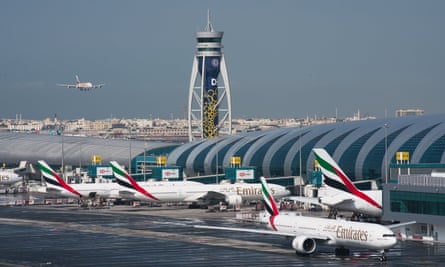London’s six airports contribute to the city’s air pollution by releasing approximately 3.23m cars’ worth of nitrogen oxides and particulate matter into the air annually. Similarly, in Tokyo and Dubai, residents are exposed to air traffic emissions equivalent to 2.78m cars.
New research has identified three cities that are heavily impacted by air pollution from aviation compared to other cities, through tracking emissions from cargo and passenger flights at global airports.
Recent studies have shown that the top 20 airports have a collective carbon footprint equivalent to 58 coal-fired power plants.
“Pollution around airports is growing year on year,” said Jo Dardenne, the aviation director at Transport & Environment, the thinktank which helped produce the research. “It affects millions of people, who breathe in toxic emissions and develop health conditions as a result, yet policymakers are brushing the problem under the carpet.
The rapid expansion of the industry and airports conflicts with their environmental objectives, particularly due to the limited implementation of sustainable technologies. The industry had promised a stronger rebound following the pandemic, but although there has been a recovery, without taking any steps, the industry’s negative impact on the environment and public health will not improve.
The ODI, in collaboration with T&E, has updated their initial research from 2021 with the 2024 Airport Tracker. This latest version now includes the carbon footprint of air freight in addition to passenger flights. The study covers 1,300 airports and examines emissions of nitrogen oxides (NOx) and fine particulate matter (PM2.5).

2, a 6.7% increase compared to the previous year
Dubai, located in the United Arab Emirates, has been identified as the most environmentally damaging airport globally. The emissions of 20.1m tonnes of CO2 from this airport increased by 6.7% in comparison to the previous year.2
In a span of one year, the amount of emissions produced is about the same as the combined emissions from five coal-fired power plants. This includes 7,531 tonnes of NOx and 71 tonnes of PM2.5.
Heathrow airport in London was the second-worst for climate impact, spewing out 19.1m tonnes of CO2
In terms of NOx emissions, this source released a total of 5,844 tonnes over the course of one year. However, it ranked 16th on the list for PM2.5 pollution with an annual output of 37 tonnes.
The situation becomes more intricate from that point, as the effects of airports on climate change and the release of other harmful pollutants are not definitively interconnected.
Some individuals who oppose air travel argue that there are not enough measures in place to prevent the pollution caused by airports. Magdalena Heuwieser, a member of the activist group Stay Grounded, pointed out that noise levels from aircraft are constantly surpassing limits and there are no EU regulations for ultrafine particles, which pose a significant health risk.
after newsletter promotion
“Urgent action must be taken to safeguard the well-being of employees and surrounding communities near airports. This could include implementing nighttime flight restrictions or making improvements to jet fuel to meet the same standards as car fuel. However, relying solely on technology will not fully address the issue; a decrease in the frequency of flights is the most impactful and necessary solution.”
According to Sam Pickard, a research associate at ODI, the decisions made about airports today have long-lasting effects on climate and air quality. Greater efforts need to be made to acknowledge and restrict the impact of airport expansion in various regions.
The Guardian reached out to the International Air Transport Association for a response.
Source: theguardian.com


